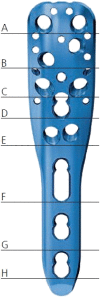Screw-Tip Augmented Locked Plating Versus Primary Reverse Total Shoulder Arthroplasty in Displaced Proximal Humeral Fractures: A Retrospective Comparative Cohort Study With a Mean Follow-Up of 39 Months
- PMID: 35070475
- PMCID: PMC8781273
- DOI: 10.1177/21514593211039026
Screw-Tip Augmented Locked Plating Versus Primary Reverse Total Shoulder Arthroplasty in Displaced Proximal Humeral Fractures: A Retrospective Comparative Cohort Study With a Mean Follow-Up of 39 Months
Abstract
Introduction: This study compared the clinical and radiologic outcomes of screw-tip augmented locking plate osteosynthesis (STA) vs primary reverse total shoulder arthroplasty (RSA) in elderly patients with displaced proximal humeral fractures.
Methods: 60 patients (age >65 years) with a displaced proximal humeral fracture underwent open reduction and internal fixation with locking plate and fluoroscopy controlled screw-tip augmentation. Sixty matched individuals (age, gender, fracture pattern, and mean follow-up) treated by RSA for fractures were identified from the institutional database and outcomes as well as occurring complications and need for revision surgery were compared.
Results: At 39 months' follow-up, 25 patients in the STA group (mean age 74.5 ± 12 years, 76.7% woman) showed a mean Constant Score (CS) of 68 ± 18.8 points. Mean %CS compared to the contralateral side was 81.6 ± 19.8%. Of 60 matched individuals in the RSA group, 22 patients (mean age 78.9 ± 8.2 years, 76.7% woman) showed a mean CS of 60.6 ± 21.2 points (P = .33), and the mean %CS compared to the contralateral side was 81.6 (74.7 ± 18.6)% (P = .14). The overall complication rate in STA group was 32% (secondary varus or valgus displacement >10°, n = 4, avascular necrosis, n = 4). In RSA group, the overall complication rate was 4.5% (P = <.05). We observed one early onset infection. Revision surgery with removal of the prosthesis and PMMA spacer implantation for two-stage revision was necessary. The follow-up rate was 41.7 vs 36.7%.
Conclusions: Screw-tip augmented locked plating and reverse total shoulder arthroplasty result in comparable satisfying functional outcome 3 years following a displaced proximal humeral fracture in elderly patients. However, we noted a higher complication and revision rate in the STA group. In contrast, primary reversed shoulder arthroplasty resulted in a lower rate of complications and revisions, which may be beneficial in elderly patients.
Keywords: augmentation; cement augmentation; locked plating; proximal humeral fracture; reverse total shoulder arthroplasty; screw-tip augmentation.
© The Author(s) 2021.
Conflict of interest statement
Declaration of Conflicting Interests: The author(s) declared no potential conflicts of interest with respect to the research, authorship, and/or publication of this article.
Figures
References
-
- Haasters F, Kindsvater J, Siebenbürger G, Mutschler W, Ockert B. Osteoporose als Risikofaktor für das Versagen der winkelstabilen Plattenosteosynthese am proximalen Humerus. Osteologie. 2014;23(01):16-21.
-
- Olsson C, Nordquist A, Petersson CJ. Long-term outcome of a proximal humerus fracture predicted after 1 year: a 13-year prospective population-based follow-up study of 47 patients. Acta orthopaedica. 2005;76(3):397-402. - PubMed
-
- Tepass A, Blumenstock G, Weise K, Rolauffs B, Bahrs C. Current strategies for the treatment of proximal humeral fractures: an analysis of a survey carried out at 348 hospitals in Germany, Austria, and Switzerland. J Shoulder Elbow Surg. 2013;22(1):e8-e14. doi:10.1016/j.jse.2012.04.002. - DOI - PubMed
LinkOut - more resources
Full Text Sources




